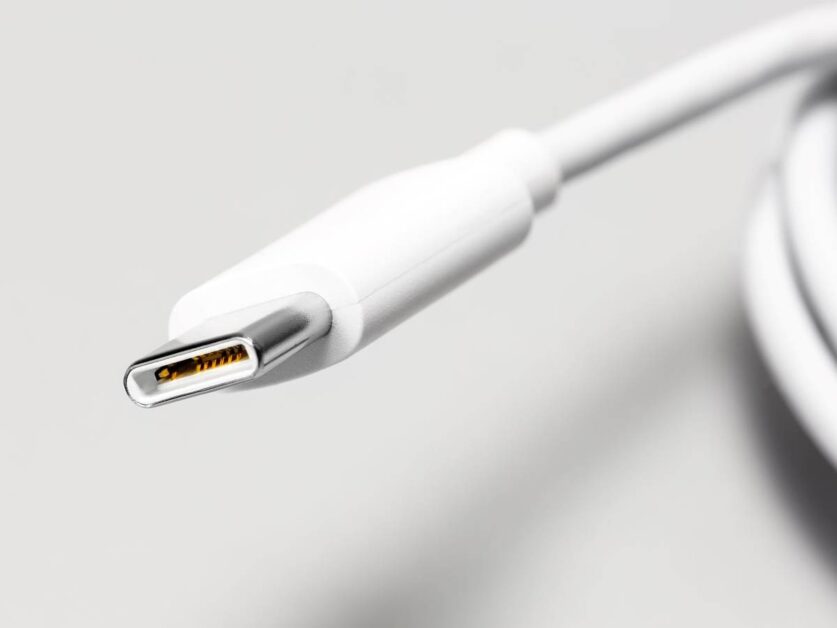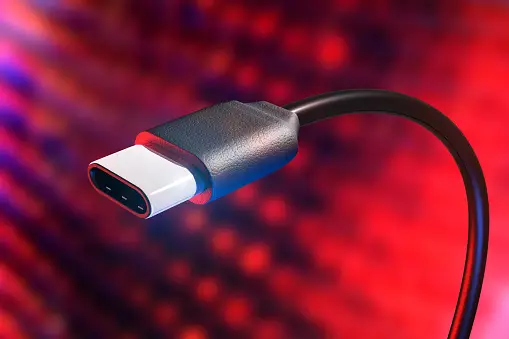USB-C is a type of connector used in USB cables for data and power transmission. It has 24 pins and its main difference in relation to previous standards is the symmetry and reversibility of the connector, which allows it to be fitted to the USB port in two orientations.
The USB Type-C connector was introduced in 2014 and gradually replaced the Micro-USB standard, common in smartphones, wireless headphones and other portable electronics. Next, understand the advantages, disadvantages and operation of the USB-C plug.
How does the USB-C connection work?
USB -C works through a reversible connector with 24 pins that transmit data and power. It was developed as an alternative to USB type A and type B connectors, which were more common in early versions of USB, such as 1.1 and 2.0.
The first version of USB Type-C was published in August 2014, a year after the release of USB 3.1. The connector is not directly related to a specific version of the USB standard, so it is possible to find type-C cables that only support USB 2.0, with a maximum speed of 480 Mb/s.
Among the 24 pins of a USB-C port, 8 are for power transmission and grounding (V Bus and GND), 8 for high-speed data (SuperSpeed), 4 for USB 2.0 data (High-Speed), 2 for cable configuration orientation (CC) and 2 for auxiliary functions (SBU).
The CC pins identify the orientation of the connector (whether it was inserted “upside down” or not), while the SBU (Sideband Use) pins are used for technologies other than USB, such as transmitting video signals via HDMI, DisplayPort and Thunderbolt.
What is USB-C Power Delivery (USB-PD)?

USB Power Delivery (USB-PD) is a USB power transmission standard that is primarily used in fast battery charging. USB-PD 1.0 supported fixed powers of 10, 18, 36, 60, and 100 watts, and was later upgraded to transmit up to 240 W at different voltage (up to 48 V) and current (up to 5 A) settings.
What is Alternate Mode on USB-C?
Alternate Mode is a specification that allows you to transmit data signals other than USB via a USB-C cable. In this mode, certain connector pins are switched to send and receive signals from HDMI, Thunderbolt, and other technologies.
DisplayPort, Mobile High-Definition Link (MHL), and HDMI let you stream video to compatible monitors and TVs via a USB cable with Alternate Mode. The inclusion of Thunderbolt in 2015 increased the versatility of USB-C because it even freed up the transmission of Ethernet signals, a protocol used in network cables.
What is a USB Type-C 2.0 cable?
A USB-C 2.0 cable is one that has a Type-C connector but does not support the high-speed data transmission of USB 3.0 and later versions. It is common in cheaper USB-C cables with USB-PD, where fast battery recharging is more important than data transfer speed.
What is the USB Type-C connector for?
USB-C was launched only as a new type of USB connector, but it can currently take on several functions:
- Data transmission via USB: this is the most well-known use of USB-C and supports different transfer speeds depending on the USB version;
- Power Delivery: USB Power Delivery supports up to 240 watts of power, which eliminates the need for additional power cables and connectors for notebooks, monitors and other types of electronics;
- Video output: it is possible to use Alternate Mode to transmit video signals in HDMI and DisplayPort from a cell phone or computer, which reduces the need for adapters or dedicated video ports;
- Audio connection: the USB-C connector in conjunction with the Audio Adapter Accessory Mode standard can completely replace the old analog plug (known as 3.5 mm or P2) in a headphone, as well as simultaneously charging the device’s battery;
- One connector to rule them all: USB-C is mandatory from USB4 onwards, and is the only connector used in Thunderbolt 3 and Thunderbolt 4, which reduces the use of adapters.
Which USB-C cable transmits video?
A USB-C cable must support Alternate Mode to transmit video, and the quality will depend on the specifications provided by the manufacturer. Mainly check the image resolution and refresh rate supported by the cable.
In general, older or cheaper USB-C cables only support 4K with a 30 Hz refresh rate , which causes an unpleasant flickering effect in the image. Furthermore, if the bandwidth is low, you will not be able to play HDR content.
Which USB-C cable charges the fastest?
A USB-C cable must support USB Power Delivery (USB-PD) and be connected to a compatible charger to transmit power at high power. In general, better cables are thicker to handle higher currents and are shorter to reduce power loss.
The version of USB-PD implemented in the cable, charger and device also affects speed. USB-PD 1.0 only supported fixed voltage and current duals (for example, 5 V and 2 A for 10 W, or 12 V and 1.5 A for 18 W), meaning it was not possible to have intermediate powers. The newer versions of USB-PD are more versatile and support variations of up to 240 W.
What are the advantages of USB-C?
- Reversibility: the USB-C connector works normally even when placed upside down, unlike old standards, which only supported a specific orientation;
- Universality: it is designed to work on any type of device, such as notebooks, cell phones, plug adapters and monitors, which eliminates the need for different types of connectors at the ends of USB cables;
- Versatility: despite being designed for USB, the USB-C standard can transmit different types of signals, such as HDMI, Thunderbolt and DisplayPort, reducing the need for adapters;
- High data transfer speed: the USB-C connector can be used in cables that transmit data at tens of gigabits per second, which is enough to display 8K images at 60 Hz with HDR10 on USB4;
- High power capacity: USB Power Delivery allows you to transmit a lot of power on the same data cable, which avoids the use of separate cables.
What are the disadvantages of USB-C?
- Lack of clarity in the standard: manufacturers do not always clearly specify the capabilities of a USB-C cable, which creates confusion among consumers ;
- Very large variation in specifications: the same connector is used in a Thunderbolt 4 cable with high data transfer speed and in a slow USB 2.0 cable with low power, which creates the inconvenience of having to find a suitable cable for each need;
- Significant differences in quality: as USB-C is a very open specification, the market has been flooded with very low quality cables, with some of them even damaging electronics due to being non-standard.
What is the difference between USB-C and Lightning?
USB-C is an industry standard connector released in 2014 by the USB Implementers Forum (USB-IF), while Lightning is a proprietary connector released in 2012 by Apple.
Lightning replaced Apple’s old 30-pin connector and became common between the iPhone 5 and iPhone 14. It is also reversible like USB-C, but has traditionally been limited to lower wattages and required paying royalties for the Apple.
What’s the difference between USB-C and Thunderbolt?
USB-C was originally a new connector developed for the USB protocol, while Thunderbolt is an interface released in 2011 by Intel and Apple for connecting peripherals to computers.
The standard Thunderbolt connector has been USB-C since Thunderbolt 3. However, to use the full capabilities of Thunderbolt technology, both the port (identified by a lightning bolt symbol) and the cable (often called an “active cable” ) must support the specification.
What is the difference between USB-C and Micro-USB?
USB-C and Micro-USB are two types of connectors used in USB. Micro-USB was most common in cell phones and portable devices. Its disadvantages were the lack of reversibility, low data transfer speed, limited charging power and shorter durability compared to USB-C.

